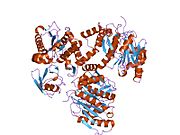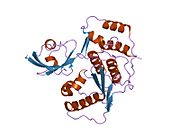
Transcription factor Sp1, also known as specificity protein 1* is a protein that in humans is encoded by the SP1 gene.
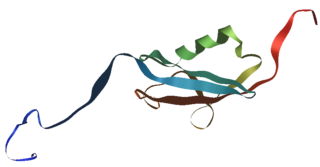
In molecular biology, SUMOproteins are a family of small proteins that are covalently attached to and detached from other proteins in cells to modify their function. This process is called SUMOylation. SUMOylation is a post-translational modification involved in various cellular processes, such as nuclear-cytosolic transport, transcriptional regulation, apoptosis, protein stability, response to stress, and progression through the cell cycle.

Small ubiquitin-related modifier 1 is a protein that in humans is encoded by the SUMO1 gene.

Promyelocytic leukemia protein (PML) is the protein product of the PML gene. PML protein is a tumor suppressor protein required for the assembly of a number of nuclear structures, called PML-nuclear bodies, which form amongst the chromatin of the cell nucleus. These nuclear bodies are present in mammalian nuclei, at about 1 to 30 per cell nucleus. PML-NBs are known to have a number of regulatory cellular functions, including involvement in programmed cell death, genome stability, antiviral effects and controlling cell division. PML mutation or loss, and the subsequent dysregulation of these processes, has been implicated in a variety of cancers.

Transcription factor 3, also known as TCF3, is a protein that in humans is encoded by the TCF3 gene. TCF3 has been shown to directly enhance Hes1 expression.

SUMO-conjugating enzyme UBC9 is an enzyme that in humans is encoded by the UBE2I gene. It is also sometimes referred to as "ubiquitin conjugating enzyme E2I" or "ubiquitin carrier protein 9", even though these names do not accurately describe its function.
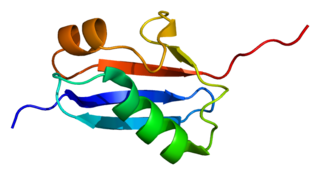
Small ubiquitin-related modifier 2 is a protein that in humans is encoded by the SUMO2 gene.

Ribosomal protein S6 kinase alpha-1 is an enzyme that in humans is encoded by the RPS6KA1 gene.

General transcription factor II-I is a protein that in humans is encoded by the GTF2I gene.

Ran GTPase-activating protein 1 is an enzyme that in humans is encoded by the RANGAP1 gene.

CDC34 is a gene that in humans encodes the protein Ubiquitin-conjugating enzyme E2 R1. This protein is a member of the ubiquitin-conjugating enzyme family, which catalyzes the covalent attachment of ubiquitin to other proteins.

E3 ubiquitin-protein ligase SIAH2 is an enzyme that in humans is encoded by the SIAH2 gene.

Nuclear transcription factor Y subunit gamma is a protein that in humans is encoded by the NFYC gene.

Lysine-specific demethylase 5A is an enzyme that in humans is encoded by the KDM5A gene.
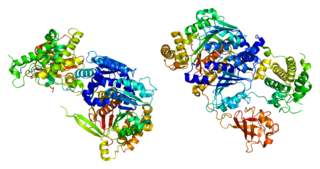
SUMO-activating enzyme subunit 1 is a protein that in humans is encoded by the SAE1 gene.

SUMO1/sentrin/SMT3 specific peptidase 3, also known as SENP3, is a protein which in humans is encoded by the SENP3 gene.

Sentrin-specific protease 6 is an enzyme that in humans is encoded by the SENP6 gene.

Sentrin-specific protease 2 is an enzyme that in humans is encoded by the SENP2 gene.

ETS-related transcription factor Elf-4 is a protein that in humans is encoded by the ELF4 gene.

Origin recognition complex subunit 1 is a protein that in humans is encoded by the ORC1 gene. It is closely related to CDC6, and both are the same protein in archaea.



































